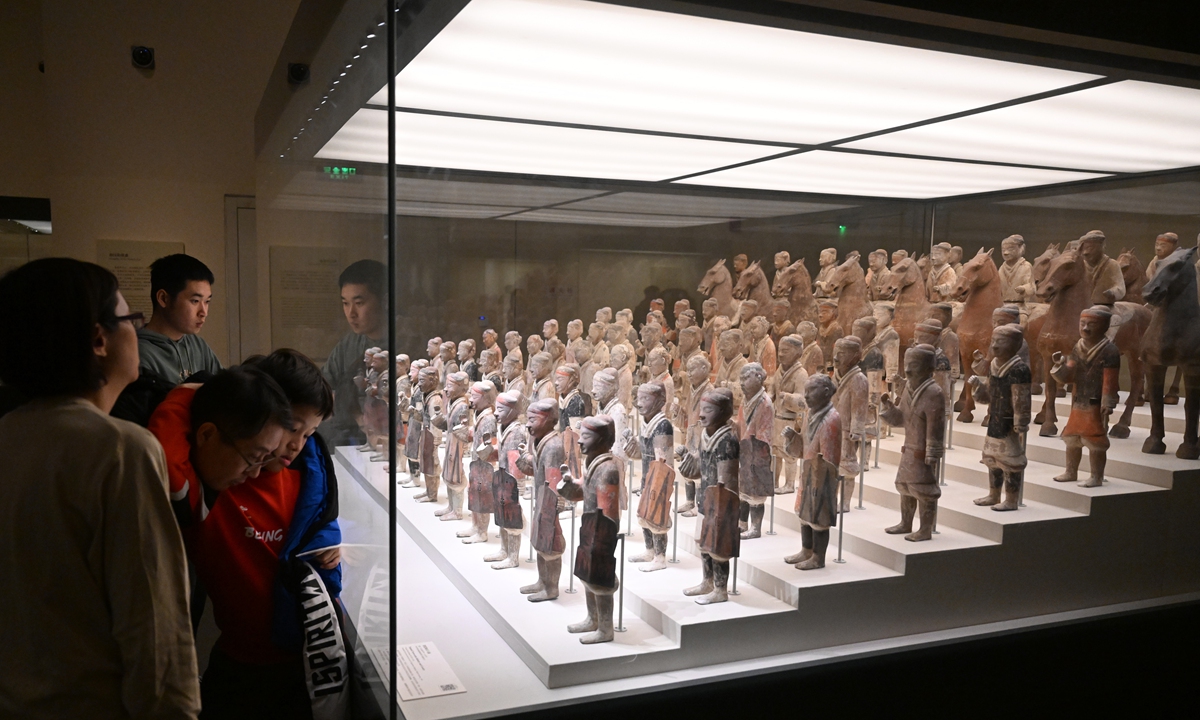
Visitors explore exhibits at the National Museum of China in Beijing on October 13, 2024. Photo: VCG
China's National Cultural Heritage Administration (NCHA) released key highlights of the cultural relics protection achievements in 2024, including that a total of 211 lost artifacts and artworks were retrieved from abroad and that museums across the country welcomed over 1.4 billion visitors throughout 2024.
According to the data released by NCHA on Wednesday, the lost cultural artifacts and artworks were repatriated from countries including the US, Japan, Argentina, and Italy.
Huo Zhengxin, a law professor at the China University of Political Science and Law, told the Global Times on Thursday that some of the cultural relics repatriated in 2024 were of significant value. For instance, in April 2024, the US returned 38 Chinese cultural relics and artworks, which predominantly consisted of Chinese Buddhist objects that date back to the Yuan (1279-1368) and Qing (1644-1911) dynasties. The repatriated artifacts encompassed a wide range of categories, including Tibetan Buddhist statues and ornaments, rare ivory and wood carvings and mural fragments that have important historical, artistic and scientific value.
According to Huo, the repatriation efforts in 2024 continued to advance based on the work of previous years. While this may not have been a record number, achieving these results amid today's more complex and challenging international geopolitical environment is commendable.
"I hope that in the future, there will be credible breakthroughs in the way cultural relic are repatriated, as well as in both the quantity and quality of the repatriated cultural relics," he said.
Experts also noted 2024 enjoyed a museum "fever" with a total of 1.4 billion visitors to these institutions.
Zhao Qingrong, deputy director of the Yinxu Museum, told the Global Times that the high number of visitors reflects the public's growing enthusiasm for cultural heritage, making it a significant part of cultural consumption.
She stated that the museum fever was not only driven by the public's recognition of Chinese traditional culture and the educational role of museums but also by the booming tourism and cultural industry, as well as the high-quality development of museums.
China Youth Daily reported that during the National Day holidays in 2024, museums across the country received 74.88 million visitors. The National Museum of China has stated that in 2024, 63,091,870 visitors had been received as of November 28, with 62.09 percent being under the age of 35.
Gao Yinwen, a docent at the museum, told the Global Times in a previous interview that the museum has always been popular among visitors from both China and abroad, especially during summer, when the daily visitor count can reach over 20,000. Since the summer period is a peak time as many students participate in study tours, the museum sets up special tour guides for them.
With the implementation of China's visa-free policies, a significant number of foreign tourists visited the Terracotta Army at the Emperor Qingshihuang's Mausoleum Site Museum in 2024. The museum was one of the hottest destinations in July, receiving a record high 3 million visitors, CCTV reported.
Another highlight of 2024 was the fourth national cultural relics census, which reviewed over 710,000 cultural relics sites from the third national cultural relics survey with a re-examination rate of over 93 percent. As a result more than 52,000 new relics sites were discovered.
According to the announcement by the State Council, the launch of the census is aimed at establishing a comprehensive national registry and database of immovable cultural relics and building a dynamic management mechanism for these assets.
According to experts, the census is primarily divided into two sections: One is to complete and supplement information on cultural relics registered during the third national cultural relics census; the other is to include newly discovered cultural relics.
Li Li, the deputy curator of Three Gorges Migration Memorial Museum in Chongqing, told the Global Times that the fourth national cultural relics census demonstrates China's determination and capability to comprehensively sort out and deeply explore its cultural heritage, laying a solid foundation for subsequent protection and research efforts.
In addition, the project to trace the origins of Chinese civilization, which proves that China's history includes more than 5,000 years of civilization and focuses on frontier archaeology and historical research, continues to advance.
Wang Wei, chief expert of the project, stated that these efforts have injected strong momentum into the cultural heritage sector, solidifying professional talent support and pushing archaeological research to new heights.




